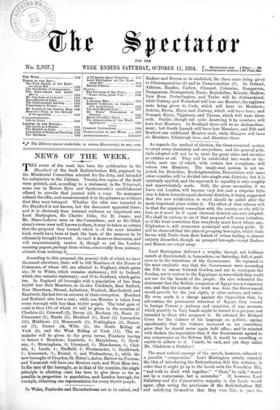According to this proposal, the general drift of which we
have discussed elsewhere, there will be 668 Members of the House of Commons, of whom 465 are allotted to England, which gains six ; 30 to Wales, which remains stationary ; 103 to Ireland, which also remains stationary ; and 70 to Scotland, which gains ten. In England all boroughs with a population of less than 10,000 lose their Members, as do also Cricklade, East Retford, New Shoreham, Stroud, Aylesbury, Wenlock, Macclesfield, and Sandwich, the last two on account of their corruption. Hereford and Rutland also lose a seat ; while one Member is taken from every borough with less than 40,000 people. The total gain of seats is thus 110, of which 56 will be given to the counties of Cheshire (2), Cornwall (2), Devon (2), Durham (4), Essex (2) Gloucester (2), Hants (1), Hertford (1), Kent (2), Lancashire (12), Middlesex (5), Monmouth (1), Nottingham (2), Somer- set (1), Sussex (20), Wilts (2), the North Riding of York (2), and the West Riding of York (11). The re- mainder will be given to the great towns, Finsbury having in future 6 Members ; Lambeth, 6; Marylebone, 6; Hack- ney, 6; Birmingham, 6; Liverpool, 6; Manchester, 6; Chel- sea, 4; Leeds, 4; Sheffield, 4; Westminster, 3; Southwark, 3; Greenwich, 3; Bristol, 3; and Wednesbury, 2; while the new boroughs of Croydon, St. Helen's, Aston, Barrow-in-Furness, and Yarmouth will have one Member each, and West Ham two. lathe case of the boroughs, as in that of the counties, the single principle in allotting seats has been to give them so far as possible in proportion to population, each London borough, for example, obtaining one representative for every 80,000 people.


































